Comprehensive Guide to Call Center Monitoring Systems

A call center monitoring system is a tool that tracks and analyzes customer interactions to ensure high-quality service. It helps you identify areas for improvement by evaluating agent performance and customer satisfaction. This system plays a crucial role in quality assurance, ensuring every call meets your business standards.
Monitoring systems improve operational efficiency and customer satisfaction significantly. For example:
- AI-powered speech analytics identify key phrases in calls, enabling targeted agent coaching.
- Active conversation intelligence platforms reduce unwanted calls by 20%, letting agents focus on meaningful interactions.
- Data-driven decisions from quality management frameworks enhance both agent training and customer experiences.
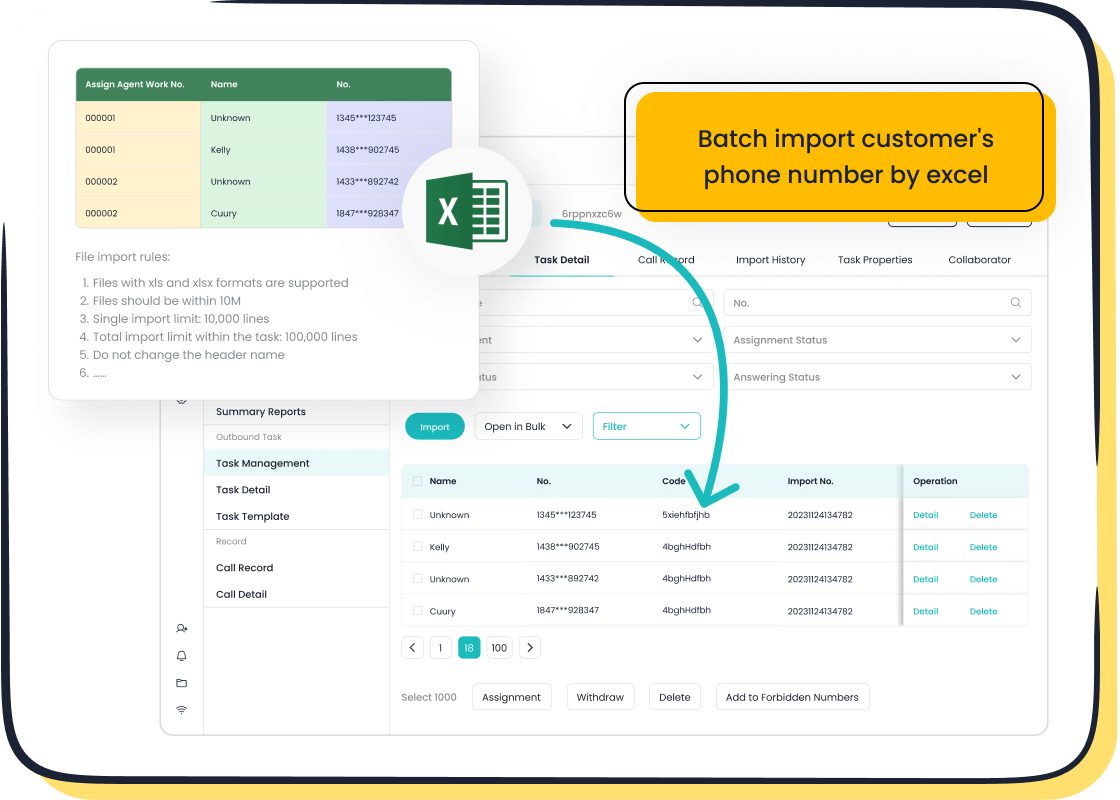
Sobot's call center monitoring system exemplifies these advantages. It combines real-time tracking, advanced analytics, and AI-driven tools to optimize your contact center operations.
Understanding Call Center Monitoring Systems
What Is a Call Center Monitoring System?
A call center monitoring system is a tool designed to evaluate and improve the performance of your contact center. It tracks customer interactions, measures agent productivity, and ensures service quality aligns with your business goals. These systems provide insights into key metrics like call resolution rates, customer satisfaction, and agent efficiency. By analyzing this data, you can identify areas for improvement and implement strategies to enhance customer experiences.
For example, industry benchmarks highlight the importance of monitoring systems in achieving measurable results:
- They help you evaluate service efficiency and customer engagement.
- Metrics like call handling times and agent productivity guide informed decision-making.
- Compliance with data security regulations ensures your operations meet industry standards.

Sobot's Voice/Call Center exemplifies these capabilities. It offers real-time monitoring, call tracking, and AI-powered analytics to help you optimize your operations while maintaining high standards of call center quality assurance.
Key Components of a Call Center Monitoring System
A robust call center monitoring system includes several essential components that contribute to quality assurance. These components work together to ensure your contact center operates efficiently and delivers exceptional customer service.
| Component | Contribution to Quality Assurance |
|---|---|
| Call Quality Monitoring | Enhances customer experience, ensures compliance, and drives operational excellence. |
| Automated Scoring Systems | Assesses calls based on criteria, helping gauge agent performance and customer satisfaction. |
| Critical Metrics Identification | Key performance indicators like call resolution rates and customer satisfaction scores gauge overall call performance. |
| Integration with Other Systems | Optimizes performance by creating a cohesive framework for analyzing call data and customer feedback. |
| Defining Quality Standards | Establishes clear objectives that align with business goals, serving as a foundation for performance assessment. |
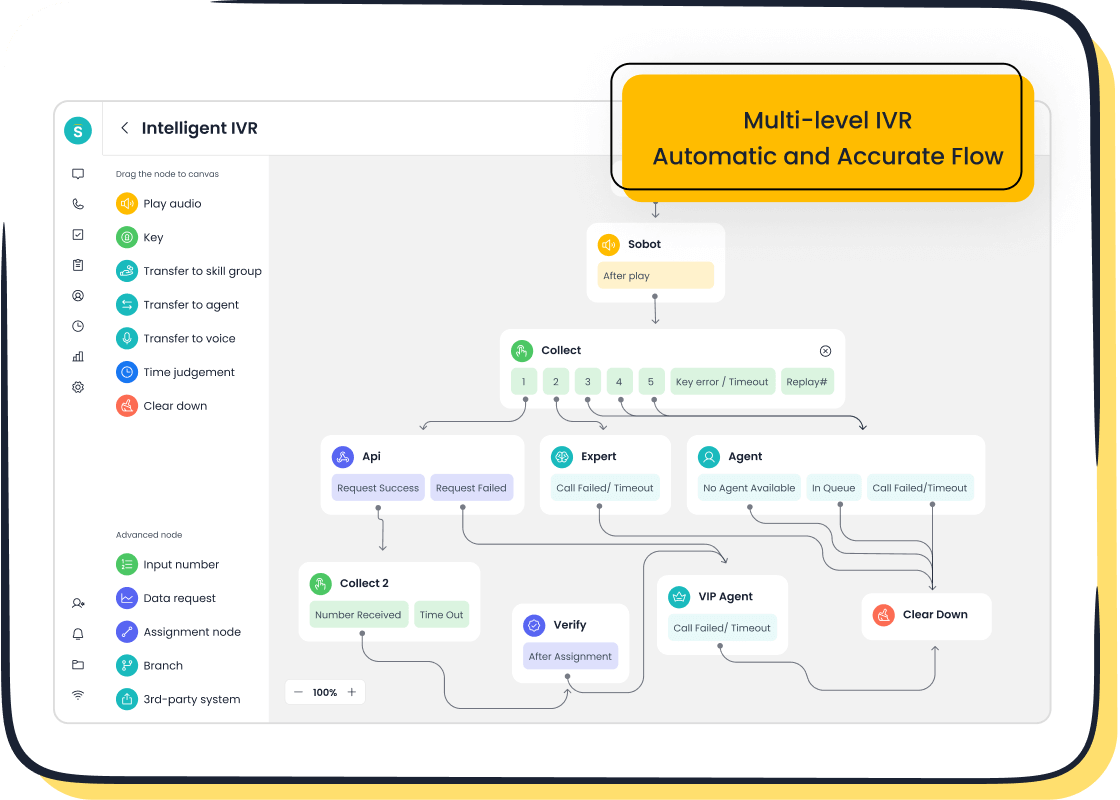
Sobot's solutions integrate these components seamlessly. For instance, its intelligent IVR system routes calls efficiently, while its AI-powered Voicebot analyzes customer intent to improve first-call resolution rates. These features ensure your monitoring system supports both operational efficiency and customer satisfaction.
How Call Center Monitoring Systems Work in Practice
Call center monitoring systems function by collecting and analyzing data from customer interactions. They use tools like call recording, real-time monitoring, and analytics platforms to provide actionable insights. Here's how they work step-by-step:
- Data Collection: The system records calls and gathers data on metrics like average handle time and customer satisfaction scores.
- Analysis: Advanced analytics tools process this data to identify trends, measure agent performance, and detect areas for improvement.
- Feedback Loop: Insights are shared with agents and managers to guide training and optimize workflows.
- Continuous Improvement: Regular monitoring ensures your contact center adapts to changing customer needs and maintains high service standards.
Real-world examples demonstrate the effectiveness of these systems. For instance:
- Telefonica Germany implemented an IVR system that improved call routing and user intent recognition, enabling 24/7 support.
- A Canadian telecommunications company increased its Net Promoter Score (NPS) by 149% by automating customer surveys and enhancing insights into customer experiences.
Sobot's Voice/Call Center takes this a step further with features like bulk outbound tasks and global number availability. These tools streamline operations and ensure your contact center delivers consistent, high-quality service.
The Importance of Call Center Quality Assurance
Why Quality Assurance Matters in Call Centers
Quality assurance ensures that your call center consistently delivers high-quality service. It helps you maintain operational efficiency, meet customer expectations, and build trust. Without effective quality assurance, you risk losing customers due to poor service experiences. Research shows that 40% of customers have switched companies in the past year because of unsatisfactory service. This highlights the critical role of quality assurance in retaining customers.
First Call Resolution (FCR) is a key metric tied to customer satisfaction. When customers’ issues are resolved on the first call, they are more likely to remain loyal. A 1% increase in FCR correlates with a 1% rise in customer satisfaction rates. By monitoring calls and providing tailored coaching to agents, you can improve FCR and overall service quality. Tools like Sobot's Voice/Call Center simplify this process by offering real-time monitoring and AI-powered analytics to identify areas for improvement.
Benefits of Contact Center Quality Assurance for Businesses
Contact center quality assurance offers numerous benefits for your business. It reduces operational costs, improves agent performance, and enhances customer satisfaction. High FCR rates not only boost customer loyalty but also increase agent satisfaction. When agents feel supported through structured feedback and training, they perform better and stay longer in their roles. This reduces turnover, which can be as high as 28% annually in call centers.
Quality assurance also helps you optimize workflows. By identifying inefficiencies and automating repetitive tasks, you can save time and resources. For example, Sobot's intelligent IVR system routes calls efficiently, reducing average handle time and improving agent productivity. These improvements directly impact your bottom line while ensuring a seamless customer experience.
Role of Quality Assurance in Enhancing Customer Experience
Quality assurance plays a vital role in creating a positive customer experience. It ensures consistent service quality, which strengthens your brand image and builds customer loyalty. Monitoring key metrics like escalation rates and time-to-resolution helps you identify pain points and address them proactively. This leads to faster issue resolution and happier customers.
Regular feedback empowers your agents to grow and perform better. A culture of continuous improvement benefits both your team and your customers. Automation tools, like those offered by Sobot, enhance workflows and maintain adherence to quality standards. By integrating customer feedback into your quality assurance practices, you can align your services with customer needs and expectations. This approach not only improves call center QA but also fosters long-term customer relationships.
Tools and Technologies for Effective Monitoring

Call Recording and Real-Time Monitoring Tools
Call recording and real-time monitoring tools are essential for maintaining high service standards in your call center. These tools allow you to evaluate agent performance, ensure compliance, and enhance customer interactions. By recording calls, you can review conversations to identify best practices and areas for improvement. Real-time monitoring, on the other hand, enables supervisors to provide immediate feedback during live calls, ensuring agents meet quality standards.
Tip: Immediate feedback helps agents adapt to customer needs in real time, improving both performance and customer satisfaction.
Technological advancements have made these tools more effective than ever. For example:
- Call Recording Software: Managers can assess agent performance and identify successful strategies.
- Real-Time Monitoring Software: Supervisors can guide agents during live calls, ensuring consistent service quality.
| Feature | Description |
|---|---|
| Auto-Synced QA Tools | Record, transcribe, and analyze calls seamlessly for better evaluations. |
| Real-Time Monitoring | Provide instant feedback and assess calls against quality metrics without manual effort. |
| Automated Transcription | Convert calls into text for easier analysis and compliance management. |
| Compliance Management | Ensure adherence to regulations and standards in call handling. |
| Advanced Analytics | Identify trends and areas for improvement, supporting continuous learning and operational efficiency. |
Sobot's Voice/Call Center integrates these features seamlessly. Its real-time monitoring capabilities and automated transcription tools simplify the evaluation process, ensuring your quality assurance program operates efficiently. With a 99.99% system uptime and global number availability, Sobot ensures reliable and scalable solutions for your call center.
Analytics Platforms for Performance Insights
Analytics platforms play a crucial role in call center quality management by providing actionable insights into agent performance and customer satisfaction. These platforms track traditional metrics like average handle time (AHT) and first call resolution (FCR), as well as advanced metrics like sentiment analysis and customer effort score (CES). By analyzing these metrics, you can identify trends, optimize workflows, and improve overall service quality.
Key metrics tracked by analytics platforms include:
- Call volume and average handling time.
- First contact resolution and agent occupancy rates.
- Net promoter score (NPS) and customer effort score (CES).
These metrics offer a comprehensive view of your call center's performance. For instance, tracking NPS can reveal customer loyalty trends, while CES highlights areas where customers face challenges. Advanced analytics tools also enable sentiment analysis, helping you understand customer emotions during interactions.
Sobot's Voice/Call Center leverages AI-powered analytics to provide deep insights into agent performance and customer experiences. Its unified workspace consolidates data from multiple channels, making it easier to monitor key metrics and implement improvements. This approach ensures your quality monitoring efforts align with your business goals.
Quality Assurance Call Monitoring Forms and Scorecards
Quality assurance call monitoring forms and scorecards are vital tools for evaluating agent performance and maintaining service consistency. These tools provide a standardized framework for assessing calls, ensuring evaluations are fair and objective. By using weighted scoring, you can prioritize criteria that align with your business objectives, such as customer satisfaction or first call resolution.
Benefits of using these tools include:
- Standardized evaluation forms for consistent assessments.
- Weighted scoring to focus on critical performance areas.
- Automated scoring to reduce administrative workload.
- Fair evaluations that minimize subjective bias.
For example, an e-commerce company implemented standardized evaluation forms to focus on problem resolution. By using data from these forms, they guided coaching efforts and observed higher customer satisfaction scores and reduced churn rates.
Sobot's quality assurance program supports these practices with features like automated scoring and real-time feedback. Its call quality monitoring tools ensure agents adhere to call center QA guidelines, improving both individual and team performance. By integrating these tools into your operations, you can enhance quality monitoring in the call center and achieve measurable results.
Sobot Voice/Call Center: A Comprehensive Monitoring Solution
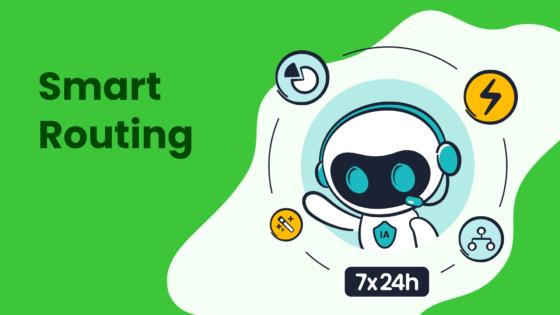
Sobot's Voice/Call Center stands out as a robust and intelligent monitoring solution designed to elevate your call center operations. It combines advanced technology, user-friendly tools, and powerful analytics to help you achieve exceptional service quality. Whether you're managing a small team or a global enterprise, this solution adapts to your needs and ensures consistent performance.
Key Features That Set Sobot Apart
Sobot's Voice/Call Center offers a range of features that simplify monitoring and improve efficiency. These tools empower you to track, analyze, and optimize every aspect of your call center operations.
- Intelligent IVR System: Customize greetings, build menus, and route calls to the right agents or teams. The drag-and-drop interface makes configuration quick and easy.
- Real-Time Monitoring: Track live calls and provide immediate feedback to agents. This ensures service quality remains high during every interaction.
- AI-Powered Voicebot: Automate repetitive tasks and recognize customer intent with precision. This reduces agent workload and improves first-call resolution rates.
- Global Number Availability: Access phone numbers worldwide to support your international operations seamlessly.
- Unified Workspace: Manage calls, customer data, and analytics from a single platform. This simplifies workflows and enhances productivity.
Did You Know?
Sobot's system boasts a 99.99% uptime, ensuring uninterrupted service for over 3 million calls daily. This reliability makes it a trusted choice for businesses across industries.
Benefits of Using Sobot's Monitoring Solution
When you implement Sobot's Voice/Call Center, you gain more than just a monitoring tool. You unlock a comprehensive solution that drives measurable improvements in your call center's performance.
- Enhanced Agent Productivity: Real-time monitoring and automated workflows allow agents to focus on meaningful interactions. For example, Samsung reported a 30% increase in agent efficiency after adopting Sobot's solution.
- Improved Customer Satisfaction: Features like intelligent call routing and AI-powered analytics ensure faster issue resolution. This leads to higher customer satisfaction scores (CSAT).
- Cost Savings: Automating repetitive tasks reduces operational costs. Bulk outbound tasks and smart call routing optimize resource allocation.
- Data-Driven Insights: Advanced analytics provide actionable insights into key metrics like average handle time (AHT) and first-call resolution (FCR). These insights help you make informed decisions to improve service quality.

Real-World Success Stories
Sobot's Voice/Call Center has transformed call center operations for businesses worldwide. One notable example is Samsung, which achieved a 97% customer satisfaction rate by integrating Sobot's solution. The unified platform allowed Samsung to streamline communication channels, improve data connectivity, and deliver personalized service. This success highlights the impact of Sobot's tools on both agent performance and customer experience.
Why Choose Sobot for Call Center Monitoring?
Sobot's Voice/Call Center offers a unique combination of reliability, scalability, and innovation. Its features cater to businesses of all sizes, from startups to multinational corporations. With seamless integration capabilities, you can connect Sobot's solution to your existing CRM systems effortlessly. The platform's AI-driven tools and global network support ensure your call center operates at peak efficiency.
Pro Tip: Leverage Sobot's analytics tools to identify trends and optimize workflows. This proactive approach can boost your Net Promoter Score (NPS) and enhance customer loyalty.
By choosing Sobot, you invest in a solution that prioritizes quality assurance, operational efficiency, and customer satisfaction. Explore how Sobot's Voice/Call Center can transform your call center operations by visiting Sobot Voice/Call Center.
Key Metrics for Call Center Quality Assurance

First Call Resolution (FCR)
First Call Resolution (FCR) measures how effectively your call center resolves customer issues during the first interaction. It is one of the most critical call center performance metrics because it directly impacts customer satisfaction and operational efficiency. A higher FCR rate means fewer follow-up calls, which saves time and resources while improving the customer experience.
Studies show that the average FCR rate is just under 70%, but achieving a world-class rate of 80% or higher can significantly enhance your call center qa program. For every 1% improvement in FCR, customer satisfaction increases by 1%, and customer retention reaches 95%. Additionally, employee satisfaction improves by 2.5%, and cross-selling acceptance rates rise by 20%. These benefits make FCR a key performance metric for any call center.
Sobot's Voice/Call Center helps you track and improve FCR with features like intelligent IVR and AI-powered Voicebot. These tools ensure accurate call routing and faster issue resolution, enabling your team to deliver exceptional service.
Customer Satisfaction Score (CSAT)
Customer Satisfaction Score (CSAT) evaluates how satisfied customers are with the service they receive. It is calculated by asking customers to rate their experience on a scale, typically from 1 to 5. Scores above 80% indicate exceptional service, while scores below 70% highlight areas needing immediate attention.
The average CSAT score across industries ranges from 75% to 85%. For example, eCommerce and retail businesses often achieve an average score of 82%, reflecting their focus on customer-centric strategies. Maintaining a high CSAT score strengthens customer loyalty and enhances your brand reputation.
Sobot's analytics tools simplify CSAT tracking by consolidating customer feedback into a unified workspace. This allows you to identify trends and implement targeted improvements, ensuring your call center meets and exceeds customer expectations.
Average Handle Time (AHT)
Average Handle Time (AHT) measures the average duration of customer interactions, including talk time, hold time, and after-call work. It is a vital metric for assessing operational efficiency. Shorter AHT indicates streamlined processes, while excessively short times may compromise service quality.
Industry benchmarks for AHT vary. For instance, telecommunications averages 2 minutes, 36 seconds, while financial services average 4 minutes, 5 seconds. Striking the right balance is essential to maintain efficiency without sacrificing customer satisfaction.
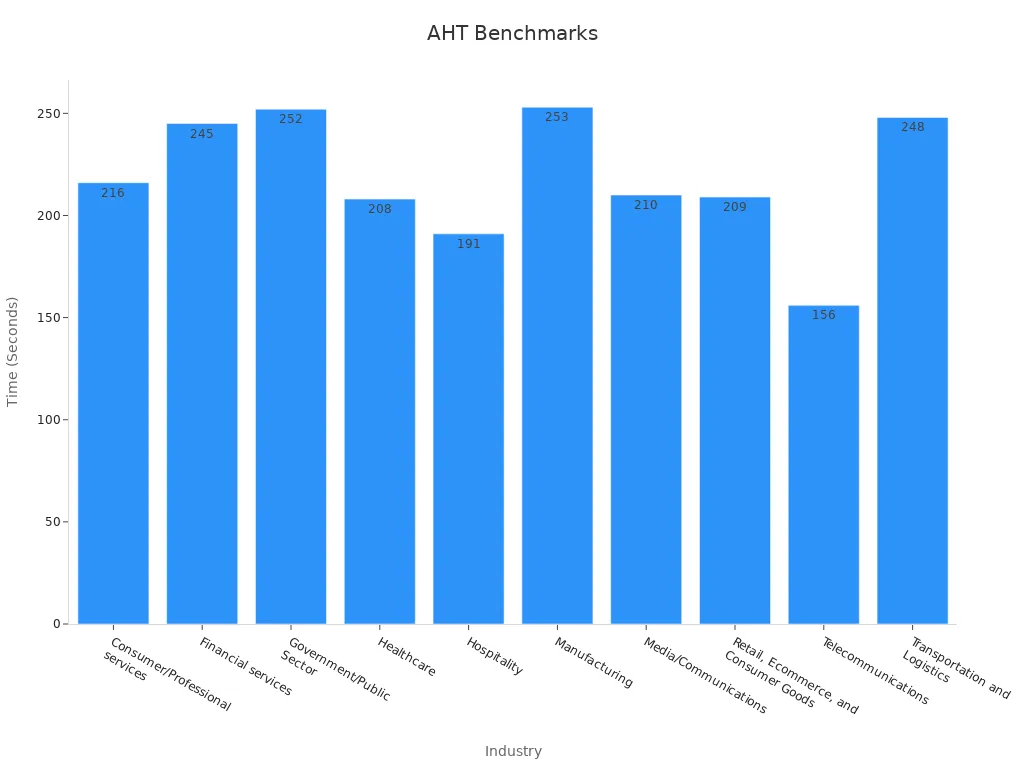
Sobot's Voice/Call Center optimizes AHT with tools like real-time monitoring and automated workflows. These features help agents manage calls efficiently while maintaining high service standards.
Net Promoter Score (NPS)
Net Promoter Score (NPS) is a critical metric for evaluating customer loyalty in call centers. It measures how likely customers are to recommend your business to others. This score provides valuable insights into customer sentiment and helps you understand how well your call center meets their expectations. Tracking NPS over time allows you to identify trends, predict customer retention, and pinpoint areas for improvement.
Did You Know?
Businesses with high NPS often experience stronger customer loyalty and increased brand advocacy. For every 10% increase in NPS, companies can see up to a 25% rise in revenue growth.
NPS works by categorizing customers into three groups:
- Promoters (Score 9-10): Loyal customers who actively recommend your services.
- Passives (Score 7-8): Satisfied but not enthusiastic customers.
- Detractors (Score 0-6): Unhappy customers likely to discourage others from using your services.
To calculate NPS, subtract the percentage of detractors from the percentage of promoters. For example, if 60% of your customers are promoters and 20% are detractors, your NPS would be 40. A positive score indicates more promoters than detractors, which is a good sign for your business.
High-quality interactions in your call center directly impact NPS. When agents resolve issues effectively and engage positively with customers, satisfaction increases. Satisfied customers are more likely to recommend your services, boosting your NPS. Research shows that improving quality assurance (QA) scores can significantly enhance NPS outcomes. This correlation highlights the importance of monitoring systems in fostering customer loyalty.
Sobot's Voice/Call Center helps you improve NPS by ensuring consistent service quality. Its real-time monitoring and AI-powered analytics enable agents to deliver exceptional customer experiences. By focusing on metrics like first call resolution (FCR) and customer satisfaction score (CSAT), Sobot empowers you to build stronger customer relationships. Learn more about how Sobot can transform your call center operations by visiting Sobot Voice/Call Center.
Pro Tip: Regularly review your NPS alongside other metrics like CSAT and FCR. This holistic approach ensures your call center remains aligned with customer expectations.
Best Practices for Call Center Monitoring
Setting Clear KPIs and Goals
Establishing clear Key Performance Indicators (KPIs) and measurable goals is essential for effective call center monitoring. KPIs provide a roadmap for evaluating agent performance and operational efficiency. When you set specific objectives, you align your team’s efforts with organizational priorities, ensuring consistent service delivery.
| Benefit | Description |
|---|---|
| Performance Insights | Provides clear visibility into agent performance and operational efficiency. |
| Quality Improvement | Identifies areas needing improvement in service quality and customer satisfaction. |
| Resource Optimization | Enables efficient allocation of resources like staffing and technology based on demand patterns. |
| Goal Alignment | Aligns agent goals with organizational objectives, enhancing overall productivity and service delivery. |
| Continuous Improvement | Facilitates ongoing enhancements in processes and customer interactions for sustained service excellence. |
For example, tracking metrics like First Call Resolution (FCR) and Average Handle Time (AHT) helps you identify inefficiencies and improve workflows. Sobot’s Voice/Call Center simplifies this process by offering real-time analytics and automated reporting tools. These features empower you to monitor progress and make data-driven decisions that enhance service quality.
Leveraging Advanced Technology Like Sobot's Solutions
Advanced technology plays a pivotal role in optimizing call center monitoring processes. Tools like AI-powered analytics, intelligent IVR systems, and real-time monitoring platforms enable you to track agent performance and customer satisfaction with precision. Sobot’s solutions exemplify these advancements, offering features that streamline operations and improve outcomes.
| Metric | Result |
|---|---|
| Reduction in inbound discussion volume | 20% |
| Increase in positive feedback | 96% |
| Correct answers provided by AI platform | Over 80% |
| Customer satisfaction rate | Over 95% |
| Self-service question resolution | 22.2% |
| Customer satisfaction score (CSAT) | 97% |
| Problems solved with Sobot solutions | 85% |
| Customer happiness rate | 99% |
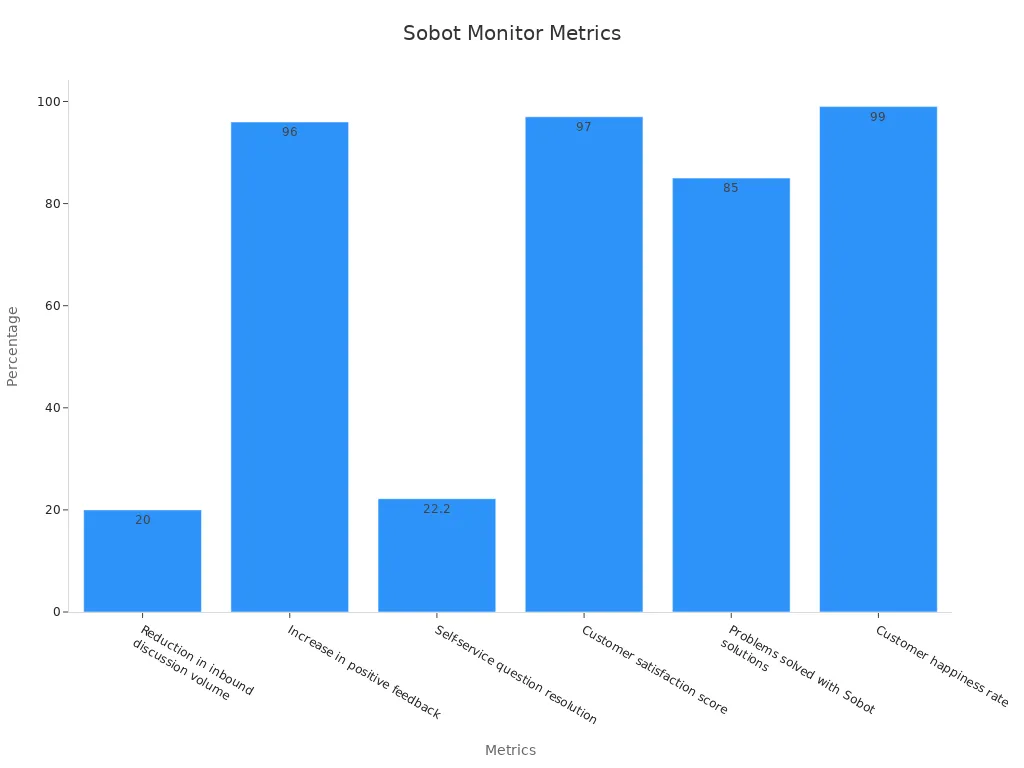

Sobot’s Voice/Call Center integrates AI-driven tools to automate repetitive tasks and improve first-call resolution rates. Its unified workspace consolidates customer data, enabling agents to deliver personalized service. By leveraging these technologies, you can implement best practices to monitor agent performance effectively and achieve measurable improvements.
Providing Constructive Feedback to Agents
Constructive feedback is a cornerstone of agent development and call center quality assurance. By offering actionable suggestions, you help agents refine their skills and enhance service delivery. Research shows that only 38% of contact center agents feel they receive adequate feedback, highlighting the importance of effective coaching.
| Evidence | Description |
|---|---|
| 38% of agents | Only 38% of contact center agents feel they receive adequate feedback to improve their performance, indicating a need for effective feedback mechanisms. |
| 30% engagement | A Gallup study shows that only 30% of U.S. employees feel engaged, with lack of feedback being a major factor, which can lead to higher turnover rates. |
Tip: Focus on specific, actionable suggestions rather than vague critiques. This approach fosters a culture of growth and encourages agents to reflect on their performance.
Sobot’s real-time monitoring tools enable supervisors to provide immediate feedback during live calls. Positive reinforcement, such as celebrating successes, motivates agents and boosts morale. By integrating feedback into your monitoring processes, you create an environment where agents feel supported and empowered to excel.
Regularly Reviewing and Updating Monitoring Processes
Regularly reviewing and updating your call center monitoring processes ensures your operations stay efficient and aligned with evolving customer expectations. Monitoring systems are not static tools. They require periodic evaluation to remain effective. By revisiting your processes, you can identify inefficiencies, adapt to new challenges, and maintain high-quality service standards.
Frequent reviews help you uncover gaps in agent performance or customer satisfaction. For instance, outdated quality assurance forms may fail to capture critical metrics. Updating these forms ensures your evaluations reflect current business goals. Similarly, revising call scripts or training materials based on customer feedback can improve first-call resolution rates and overall satisfaction.
Case studies highlight the benefits of regular process reviews:
| Case Study | Impact on Call Center Operations |
|---|---|
| Support Line Oversight | Significant improvements in satisfaction rates and accountability culture. |
| Compliance Audits | Promotes continuous improvement and higher standards of accountability. |
These examples demonstrate how proactive reviews lead to measurable improvements in call center performance.
Sobot’s Voice/Call Center simplifies this process with tools like real-time monitoring and automated analytics. These features allow you to track key metrics, such as average handle time and customer satisfaction scores, in real time. By leveraging these insights, you can make data-driven updates to your monitoring processes. For example, Sobot’s intelligent IVR system enables you to refine call routing strategies, ensuring customers reach the right agents quickly.
Pro Tip: Schedule quarterly reviews of your monitoring processes. Use analytics platforms to identify trends and adjust your strategies accordingly. This approach keeps your call center agile and customer-focused.
Regular updates to your monitoring system ensure your call center remains competitive. They also foster a culture of continuous improvement, benefiting both your agents and your customers.
Overcoming Challenges in Call Center Monitoring
Balancing Automation with Human Oversight
Automation has transformed call center monitoring, but finding the right balance between technology and human involvement remains a challenge. While automation improves efficiency, it cannot replace the empathy and critical thinking that human agents bring to customer interactions. To achieve this balance, you must address several key challenges:
- Resistance to change: Employees may worry about job security when automation is introduced.
- Data privacy concerns: Handling sensitive customer data requires robust security measures.
- Algorithmic biases: AI systems can unintentionally reflect societal biases, making ethical oversight essential.
- Managing expectations: Misunderstandings about AI capabilities can lead to unrealistic goals.
- Adapting to rapid advancements: Staying updated on evolving technologies ensures your systems remain effective.
One effective strategy is the agent-bot transfer approach, where AI handles routine tasks and seamlessly transfers complex issues to human agents. This ensures customers receive personalized support when needed. Additionally, continuous human oversight of automated processes helps align them with your brand values and customer expectations. Sobot’s Voice/Call Center exemplifies this balance by combining AI-powered tools with real-time monitoring, ensuring both efficiency and a human touch.
Addressing Resistance to Feedback Among Agents
Agents often resist feedback due to fear of criticism or misunderstanding its purpose. Overcoming this requires a supportive and transparent approach. Involving agents in the quality assurance process fosters trust and encourages acceptance. For example:
| Strategy | Description |
|---|---|
| Creating Evaluation Criteria | Involving agents in setting evaluation standards fosters ownership. |
| Establishing Feedback Loops | Providing constructive feedback regularly supports continuous improvement. |
You can also include agents in change management plans to make them feel valued. Involving them in setting KPIs and metrics gives them a sense of ownership. Training sessions that highlight the benefits of feedback further reduce resistance. For instance, showing how feedback improves first-call resolution rates can motivate agents to embrace it. Sobot’s real-time monitoring tools simplify this process by enabling immediate, constructive feedback during live calls.
Ensuring Data Security and Compliance in Monitoring
Call center monitoring involves handling sensitive customer data, making security and compliance critical. Failing to protect this data can lead to legal issues and loss of customer trust. To ensure compliance, you should:
- Implement encryption protocols to secure data during storage and transmission.
- Regularly update systems to address vulnerabilities.
- Train agents on data privacy regulations like GDPR or CCPA.
Sobot’s Voice/Call Center prioritizes security with encrypted data transfer and compliance management tools. Its 99.99% system uptime ensures reliable operations, while its global network supports secure communication across regions. By integrating these practices, you can maintain customer trust and meet regulatory requirements.
Pro Tip: Regular audits of your monitoring processes help identify and address potential security gaps, ensuring your call center remains compliant and trustworthy.
Implementing a robust call center monitoring system is essential to improve customer service and ensure operational excellence. These systems help you track key metrics, optimize workflows, and enhance agent performance. Tools like real-time monitoring, analytics platforms, and quality assurance scorecards simplify this process. By adopting best practices, such as setting clear KPIs and leveraging advanced technologies, you can achieve measurable improvements. Sobot's Voice/Call Center offers a comprehensive solution to streamline your operations and deliver exceptional customer experiences. Explore its features to elevate your call center's performance today.
FAQ
What is the purpose of call center monitoring systems?
Call center monitoring systems track customer interactions to improve service quality. They help you measure agent performance, identify inefficiencies, and enhance customer satisfaction. For example, Sobot's Voice/Call Center uses real-time monitoring and analytics to optimize workflows and ensure consistent service delivery.
How can call center monitoring systems improve agent performance?
Monitoring systems provide actionable insights into agent behavior. They highlight areas for improvement, enabling targeted coaching. Sobot’s real-time monitoring tools allow supervisors to offer immediate feedback during calls, helping agents refine their skills and deliver better customer experiences.
Are call center monitoring systems secure?
Yes, modern systems prioritize data security. They use encryption protocols and comply with regulations like GDPR. Sobot’s Voice/Call Center ensures secure data transfer and storage, maintaining a 99.99% system uptime for reliable operations.
Can call center monitoring systems reduce operational costs?
Absolutely! These systems automate repetitive tasks and optimize workflows. For instance, Sobot’s intelligent IVR system reduces average handle time, saving resources while improving efficiency. Businesses often see significant cost savings after implementation.
How does Sobot’s Voice/Call Center stand out?
Sobot’s Voice/Call Center combines advanced features like AI-powered Voicebot, global number availability, and real-time analytics. It adapts to businesses of all sizes, ensuring high-quality service and measurable improvements in metrics like first-call resolution and customer satisfaction.
See Also
Enhancing Call Center Efficiency Through Effective Monitoring Strategies
Essential Principles of Quality Management Systems in Call Centers
Navigating Quality Assurance Software for Call Center Success
Exploring Comprehensive Omnichannel Solutions for Call Centers
Top Best Practices for Effective Call Center Quality Management